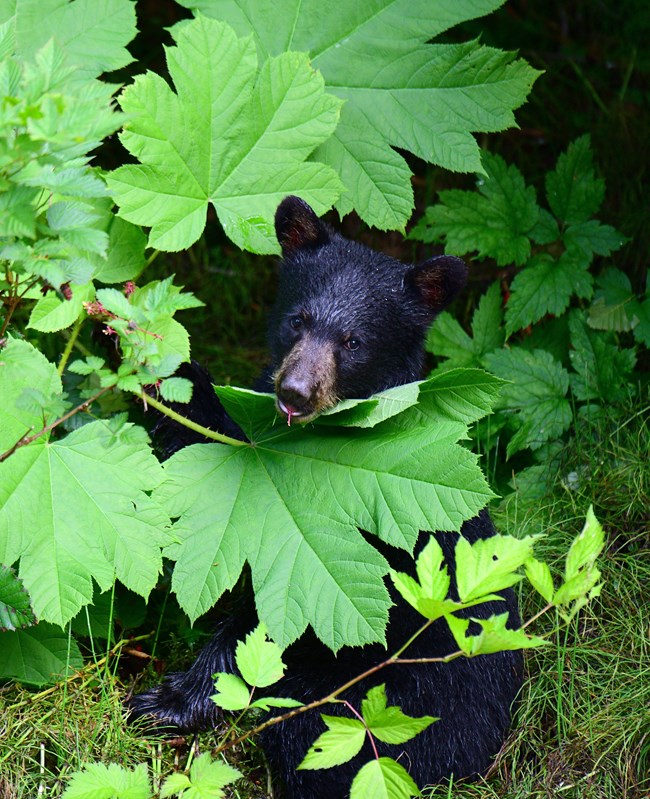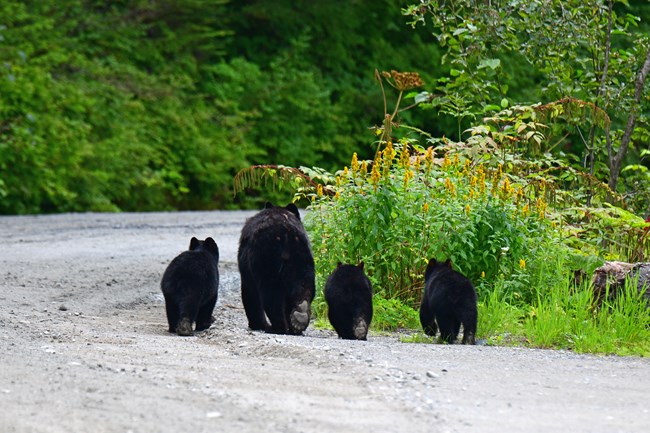Last updated: December 9, 2022
Article
Report of Black Bear Cub with Avian Influenza in Glacier Bay National Park

NPS Photo / T. Lewis
From May to early October 2022, a mother black bear with 3 cubs of the year frequented the park headquarters in Bartlett Cove foraging for wild foods along the roadside and near buildings. In mid to late October, one of the three bear cubs began acting erratically and showed signs of deteriorating health. Park biologists and officials from NPS and the State of Alaska made the difficult decision to euthanize the animal to protect public safety and other wildlife. Lab results revealed that the bear cub tested positive for Highly Pathogenic Avian Influenza (HPAI). The following account details the bear cub’s symptoms and agency response.
On October 11 the family group spent 2-3 hours near park offices. All cubs appeared active, healthy and were feeding on ground cone (Boschniakia rossica). The next day the family was seen near park housing where a park staff member noticed one of the cubs was often at a distance from the rest and not feeding like the others. On October 14th the mother passed by park offices around 1 pm with only two cubs. At 3:30 the third cub walked by moaning and sniffing, presumably looking for the rest of the family. The cub looked healthy and eventually moved off in the direction of the other bears.

NPS Photo / T. Lewis
On October 15th a single black bear cub was seen along the park road near the driveway to the park’s maintenance building stumbling, moaning, and approaching and trying to get under cars. The bear appeared to have trouble placing its paws on the ground and sometimes ended up falling on its head. There were no signs of trauma or discharge from mouth or eyes and the bear looked healthy except for its movements. A park biologist was able to coax the bear to the road shoulder, but the bear remained in the area throughout the rest of the day. The next morning (October 16th) park staff observed the cub in the same area having seizures and foaming at the mouth. After the seizures ended the cub slept in the same location all morning and afternoon until nightfall.

NPS Photo / T. Lewis
The following morning (October 17th) the cub was gone from its previous location. Park staff found the cub later in the day ambling clumsily back and forth across the road in the same area. At this point the cub seemed to be blind and deaf with no response to sights or sounds. The bear moved constantly, often walking in circles and running into buildings and objects. Park staff herded the cub into a temporary enclosure for public safety. The bear circled the enclosure, mostly clockwise, bumping into the walls. For the next three days (Oct. 18-20) the cub alternately slept or walked in circles. Occasionally the bear investigated the enclosure but made no efforts to climb out or escape the enclosure. The bear did not respond to sight or sounds, showed no interest in water, and responded only slightly to smells of people.
The park biologist consulted with federal and state biologists and veterinarians and all agreed that the cub should be euthanized to protect people and other wildlife in case the bear had rabies or Avian Influenza or another communicable disease. On October 20th a state biologist euthanized the animal with a .22 caliber rifle. A quick assessment found the cub to be a male with no broken bones or obvious signs of trauma. The enclosure had no signs of vomit, feces, or any other discharge from the bear during his 3 days there. The carcass was sent to the state veterinarian for necropsy.
The approximately eight-month-old, 32-pound cub was found to be generally in good body condition but had hemorrhaging along the left side of the skull and a swollen brain. Laboratory analysis results found the bear to be negative for rabies and canine distemper but positive for Highly Pathogenic Avian Influenza (HPAI) in brain tissue as well as nasal and rectal swabs. HPAI has been detected in only one other black bear, in Quebec in June 2022. In Alaska the virus has previously been detected in only two mammals, both red foxes, but has been detected in numerous wild and domestic birds throughout the summer and fall. The bear cub was likely exposed to the virus by consuming an infected bird. For more details see Black bear cub in Alaska diagnosed with Avian Influenza.
Avian Influenza has not been detected in any other animals in Glacier Bay National Park, but park biologists will continue to monitor wildlife populations and send deceased animals in for laboratory testing. If you see sick birds or mammals behaving strangely, please report immediately to park staff, Alaska Department of Fish and Game, or U.S. Fish and Wildlife Hotline: 866-527-3358.
Glacier Bay National Park contact: Tania Lewis, email Tania here, 907-697-2668
Highly Pathogenic Avian Influenza and Migratory Birds in Alaska | U.S. Fish & Wildlife Service (fws.gov)
Avian Influenza (Bird Flu) (alaska.gov)

NPS Photo / T. Lewis
